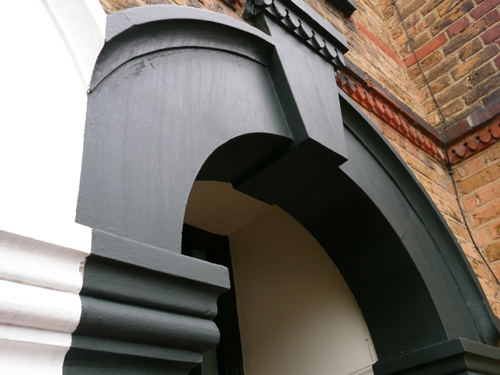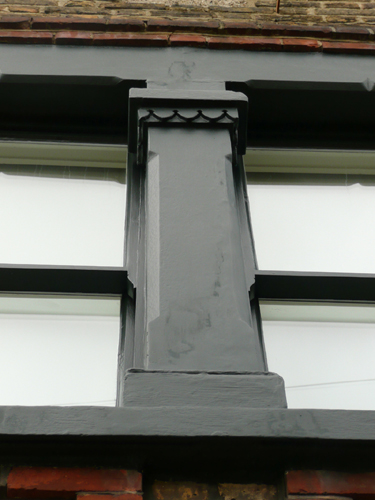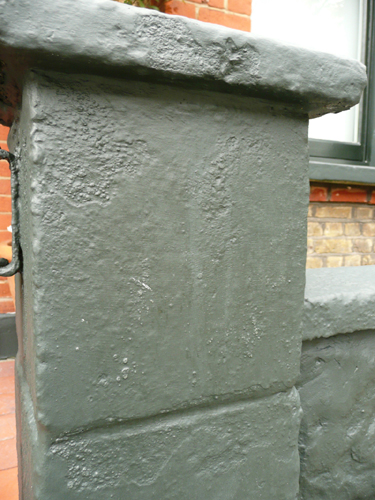
Background
A complaint about masonry paint that we had supplied had prompted me to write up an earlier problem (Black Paint – Red Faces ). On that occasion airborne dirt settling on the façade of a newly-painted house had led a client to threaten us with legal action.
However lessons learned during this recent ‘situation’ have been sufficiently useful that I felt that they ought to be more widely known and understood. The account is also another reflection on human nature and the difficulties of trying to run a small business.
Paints are very sophisticated blends of numerous ingredients, which all serve a purpose. If applied properly the results are usually good and a durable attractive finish results. However, it is very important to follow the guidelines otherwise there can be problems. This is especially true when painting exteriors.
On this occasion our client had ordered a tin of masonry paint for the external detail of her West London house. The colour that she wanted was our Shop Front Green – so named because we developed the colour for the exterior of Papers and Paints some 25 years ago.
The paint was collected at the end of September.
The Complaint
While on a brief half-term holiday in Portugal I had a call from the Shop to say that we had a problem. The paint that we had supplied was “streaking badly” and that the client wanted us to make a site visit to explain what was happening. I listened to the facts and then telephoned the client to explain what I thought might be the cause of her difficulty. The gist of my response was that an early October with indifferent weather was perhaps not the best time to paint an exterior.
However, I didn’t succeed in convincing her and was told that I had been both patronising and had failed to take her complaint seriously. Furthermore, in her twenty years experience as an interior designer1 she had never encountered such a problem.
It was inevitable that I would receive an email shortly after my return inviting me to visit the property with a suggestion that Trading Standards would become involved if I failed to do so. Interestingly I was assured that the streaking had nothing to do with the weather. Casting aside a day planned for microscopy I negotiated the roadworks of West London and made a journey to examine the paint.
Appearance
Certainly, when viewed obliquely one could see greyish streaks on the dark green paint. It was clear that subsequent rain had caused these to run down the surfaces. Samples of the deposits were taken for subsequent microscopic analysis and numerous photographs taken.
The paint seemed to have been applied well, although there were areas where sections of ‘making-good’ (i.e. filling) had not been adequately primed before subsequent coats of paint. The result was that there were patches of ‘sunken’ paint, where the filler had absorbed the overlaid masonry paint. I took this as an indication that the painter could have carried out a better job.

While on site I observed that the house faced West and that a small tree was growing in front of it on the pavement – the latter providing some shelter.
An hour or so on the Internet gave me the meteorological data for London during the period between which our client had bought the paint and when she telephoned. This data consisted of the following:
1) Temperature range and average;
2) Overall weather conditions e.g. Rain, fog, overcast, cloudy, partly cloudy, clear;
3) The Relative Humidity range and average;
4) The wind speed;
5) The Dew Point temperature; and
6) The difference between ambient temperature and dew point.
A telephone call to the manufacturers of the paint confirmed what I had already told the client – that it was not recommended that exterior surfaces are painted between October and March.
I also checked the instructions on the tin and saw that they clearly stated that paint should not be applied below 45°F or during rain, fog or relative humidity (RH) above 80%.
Whilst the temperature was not recorded as falling below 45°F, on most of the days in question the average RH had been above 80%. On only two days did the RH not reach 80%, but on both these occasions the weather was recorded as “Rain, overcast, cloudy” or “Rain, overcast, cloudy, partly cloudy, few clouds, clear”. Indeed on two occasions the RH was as high as 100%.
Paint and the Damp
All water-based masonry paints contain some water-soluble ingredients, such as glycols, dispersants, surfactants (wetting agents) and thickeners. These are required for colour, stability, and ease of application. These ingredients usually either evaporate, or they leach from the paint due to rain or dew drying on the painted surface shortly after the paint has dried. They tend to occur if masonry paint is applied during cool and damp conditions, or just before it occurs, such as late afternoon or just before or right after rain. They will also occur when the temperature falls within 5°F of the dew point. 2 If this happens the drying is retarded and the ingredients come to the surface before the paint has had a chance to dry. 3 When the moisture dries, concentrated surfactants that have been deposited on the painted surface will immediately become noticeable as they are different in colour to the paint.

This phenomenon (which I had seen a couple of times before, but was not aware of the name) is called surfactant leaching.
The fact that the front of the house faced West meant that the surfaces took longer to warm up. As a result it was some time before the dew had evaporated and before paint could safely be applied. On some days the daytime evaporation can be so slow that dew may persist all day. If the weather has been cloudy this will also reduce the chance of the dew evaporating. Furthermore, if it has rained or been foggy there will be more moisture to contend with.
It was observed that of the days between the purchase of the paint and our client’s complaint only one was recorded as not having had either rain or fog. All of the days were also recorded as having been overcast or cloudy.
Dark Paints
Dark paints which are tinted using universal colourants are more prone to this condition than white or ready mixed colours because of the surfactants and glycols present not only in the paint, but also in the colourant. The surface deposits will always be more noticeable on a dark coloured masonry paint. In most cases, surfactants come out of the paint film slowly and are washed away undetected – especially with light colours. Surfactants are not part of the paint film and their migration from the film does no harm to the paint film whatsoever. Surfactant leaching is an inconvenience caused by conditions not ideal for painting and is not a paint defect. While it usually has no adverse effect on the long-term durability of paint, it can temporarily affect the appearance of a job before it naturally weathers off in a month or two.
Avoidance
To minimize the possibility of surfactant leaching, it is always best to avoid painting the exterior of a house between October and March. Similarly one should avoid painting late in the day, especially in the spring and autumn when cool, damp conditions are expected in the evening or overnight. One should also avoid painting just before it rains.
Remedy
While surfactant leaching will normally weather off, one may find that careful washing off with plain water and a sponge will suffice. One must first ensure that the paint film has hardened and also be aware that dark colours can be marred by even slight abrasion so a trial is always recommended.
If the surfactant cannot be removed without damaging the paint, touching up or repainting over the surfactant may be required.
In general, surfactant leaching does not adversely affect the film integrity or exterior durability of the paint.
Our Response
Our response could hardly have been more prompt:
1) When the problem had been brought to my attention I had telephoned the client from my holiday in Portugal.
2) Within a few hours of receiving an email of complaint I had visited the house and taken samples.
3) An email had been sent informing the client of my actions.
4) Before the end of the day a six page report had been sent to the client explaining what the problem was; what had caused it and possible solutions.
To date I have not had a response, let alone a thank you.
NOTES
1 It is a depressing fact that few interior designers trouble themselves with learning even the basics about paint. Those that do, stand out a mile, and one knows that the attention to detail that this shows will be consistent throughout their work.
2 The dew point is the temperature at which dew would form assuming all other conditions remained the same. It is a function of the air temperature and humidy. The dew point temperature can never be higher than the air temperature. If the dew point temp and air temp are the same the humidity must be 100%.
3 The temperature did fall within 5° F of the dew point on nearly half of the days in question. On top of this one must factor in the West-facing outlook and the shelter provided by the tree, which meant that the sun had little chance to dry the surfaces.
View Larger Map












A very interesting and instructive post, Patrick! It is obvious that product instructions must be followed when applying. I’ve learned a lot and I’m glad all ended well for you. Most important, your quick response to the client, a very important lesson for Interior Designers, Architects and Color Consultants.
Thank you Isabel. I think that the key lesson here is that one is never too experienced to learn yet more. I am still finding out more about paint and colour after thirty years in the business. Sadly, there are a few interior designers who believe that this doesn’t apply to them.
Very educational, even for me as a Decorator of 30 years +, don’t you just love people that call them self a ‘designer’ and know little or nothing of how a job should be done, or the pit falls of wrong doing! and to get no thanks, well that just says it all.
Indeed. It would be good if some of these ‘designers’ actually followed a recognised course of study. The word is bandied about too much by the unqualified.
This is a fascinating post Patrick as is your “Black Paint – Red Faces” one. I love the fact that it is both educational and entertaining. Your research feels to me like a detective’s work.
Thanks Corinne. Tongue in cheek, I have been called ‘The Paint Detective’ (in the USA ‘The Colombo of Color’). These situations are sent to try one. Fortunately a little knowledge manages to deal with them.
An excellent appraisal, most informative.
We have a large 250 year old Georgian property, The Golden Lion in Ashburton , Devon and I am thinking of painting it black. It has a massive West facing side and garden wall…. I am now re considering given your excellent post. Am I being overly cautious?